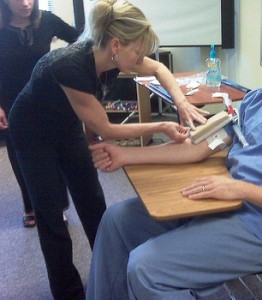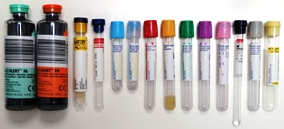Phlebotomy Training Curriculum

The study of phlebotomy is a process that incorporates both practical, book-based study and hands-on practice. When choosing your phlebotomy training program, be sure that it offers both components. All certification agencies require a certain number of successful venipunctures for certification. Additionally, verify that the facility where your hands-on practice is conducted meets the requirements of the Clinical Laboratory Improvement Amendment. Additional information on laboratory standards is available from the U.S. Food & Drug Administration:
Classroom Training In Your Phlebotomy Program
Topics that you might encounter in the classroom portion of your training include:
- Anatomy
- Physiology
- Systems of the body
- Circulatory system
- Urinary system
- Lymphatic system
- Muscular / Skeletal system
- Composition of blood and blood-cells
- Laboratory procedures and etiquette
- CPR
Other Possible Topics
Comprehensive phlebotomy training programs will include additional topics of study beyond the core competencies. A few of the subjects you might encounter in a more broad-based curriculum include:
- Professionalism and ethics
- Legal issues involved in phlebotomy
- Basic computer proficiency
- Quality control guidelines
The classroom portion of your phlebotomy training will acquaint you with the various types of venipunctures and the steps involved in each. You will learn how to properly interpret and follow blood draw requisitions as well as the procedures for labeling samples once the blood draw has been completed. You will also become familiar with the equipment used in phlebotomy.
 One of the highly critical elements of phlebotomy is the order of draw. When drawing blood, the draw needs to be done in a very specific order to avoid cross-contamination of the specimens. Considerable time will be spent on this facet of your phlebotomy training. You will also encounter questions regarding the order of draw on your phlebotomy certification exam.
One of the highly critical elements of phlebotomy is the order of draw. When drawing blood, the draw needs to be done in a very specific order to avoid cross-contamination of the specimens. Considerable time will be spent on this facet of your phlebotomy training. You will also encounter questions regarding the order of draw on your phlebotomy certification exam.
Hands-on Training In Your Phlebotomy Program
In the hands-on portion of your phlebotomy training program you can expect to encounter at least some of the following:
- Blood Draw Site Selection – This is an important part of your training. (It’s not choosing the room where you will perform the blood draw) Blood draw site selection involves determining which vein to use for extracting the blood sample. You will learn the most common draw sites on the patient and how to determine which area is best to use.
- Equipment – You will be trained in the various types of needles and learn how to determine which needle is appropriate in various circumstances.
- Procedures – There are specific procedures that must be followed in each blood draw including identifying the patient, positioning yourself and the patient, prepping the vein, and labeling the samples.
Safety In Phlebotomy
In any quality phlebotomy training program there will be an emphasis on safety for both the patient and the phlebotomist. You will learn about:
- How to prevent hematoma
- Proper tourniquet application
- Infection control
- Protecting yourself and the patient
- Safety procedures
- What to do in the case of an accidental stick
It’s About Professionalism
There is so much more to phlebotomy or venipuncture than just sticking a needle in someone’s arm and extracting blood. The right training course will take you down the path to becoming a true professional in every sense of the word. When choosing your phlebotomy training course, do some in-depth research to find out exactly what is involved in the training and how detailed and comprehensive it is. And, don’t forget, be sure it includes the hands-on practice that you will need.




